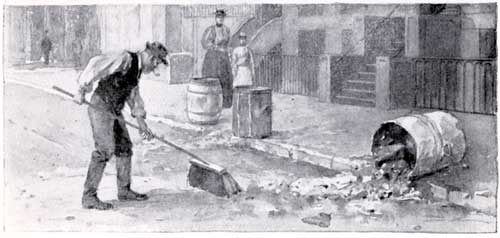![]()
The Blizzard of 1888 dramatically transformed
the landscape of New York City, dumping a blanket of snow, felling trees
and overhead wires, and turning a usually bustling metropolis into a
series of barren streets dotted only by individuals struggling towards
shelter. The southeasterly wind that accompanied the storm packed massive
snowdrifts on the northern sides of streets throughout Manhattan. Thirty
six hours after the blizzard first hit, when the snow stopped and the
winds calmed, revelers on sleighs and children adventurous enough to
scale the massive drifts-- or tunnel through them-- made the most out
of New York's transformation. But such blockage was a tremendous problem
for a city with over two hundred miles worth of streets, and a poorly
organized system to keep them clean and clear of impedimenta.
In 1881, the newly formed Department of Street Cleaning had taken over
the responsibility for waste collection and street cleaning from the
Metropolitan Board of Police. The department was faced daily with the
monumental task of clearing streets cluttered with an ever mounting
tonnage of waste-- the several hundred pounds of natural waste generated
daily by the sixty thousand horses that clopped around New York was
overwhelming enough.
James Coleman was the first Commissioner of Street Cleaning, and under
his direction the department was a shambles, poorly funded and inefficiently
organized. Coleman contracted certain streets for cleaners to tend while
hiring and appointing cleaners to others, focusing the department's
resources primarily on the main thoroughfares of the city. The city
hired no regular, salaried street cleaners, only itinerant workers employed
at the whim of a commissioner who took his rules of conduct from Tammany
Hall's patronage system. The tenement areas on the east and west sides
of Manhattan were left largely untouched, and other more affluent residential
areas would only be cleaned when private property owners hired workers
to sweep the streets. As New York City's population expanded at the
end of the nineteenth century, and its residential districts grew more
dense, the struggle to keep the city clean was an increasingly visible
civic problem.
This image was also
taken from Externals of Modern New York, and features the
"White Wings" at work. |
| The Department of Street Cleaning improved dramatically after Col. George Waring created a permanent, disciplined army of sanitation workers in 1895-- known as the "White Wings" for their clean, white uniforms. The department eventually changed its name to the Department of Sanitation-- and to this day it handles both garbage and snow removal. Several blizzards since 1888 have paralyzed the city, dramatically altering its landscape-- nearly every decade since 1888 has had at least one mammoth snowstorm. These storms have shut the city down, and required extensive cleanup. But because of the lessons learned during the Great Blizzard--about the benefits of anticipating such snowfall and the importance of mounting an organized response-- none has impacted the city as severely as the Blizzard of 1888. |


